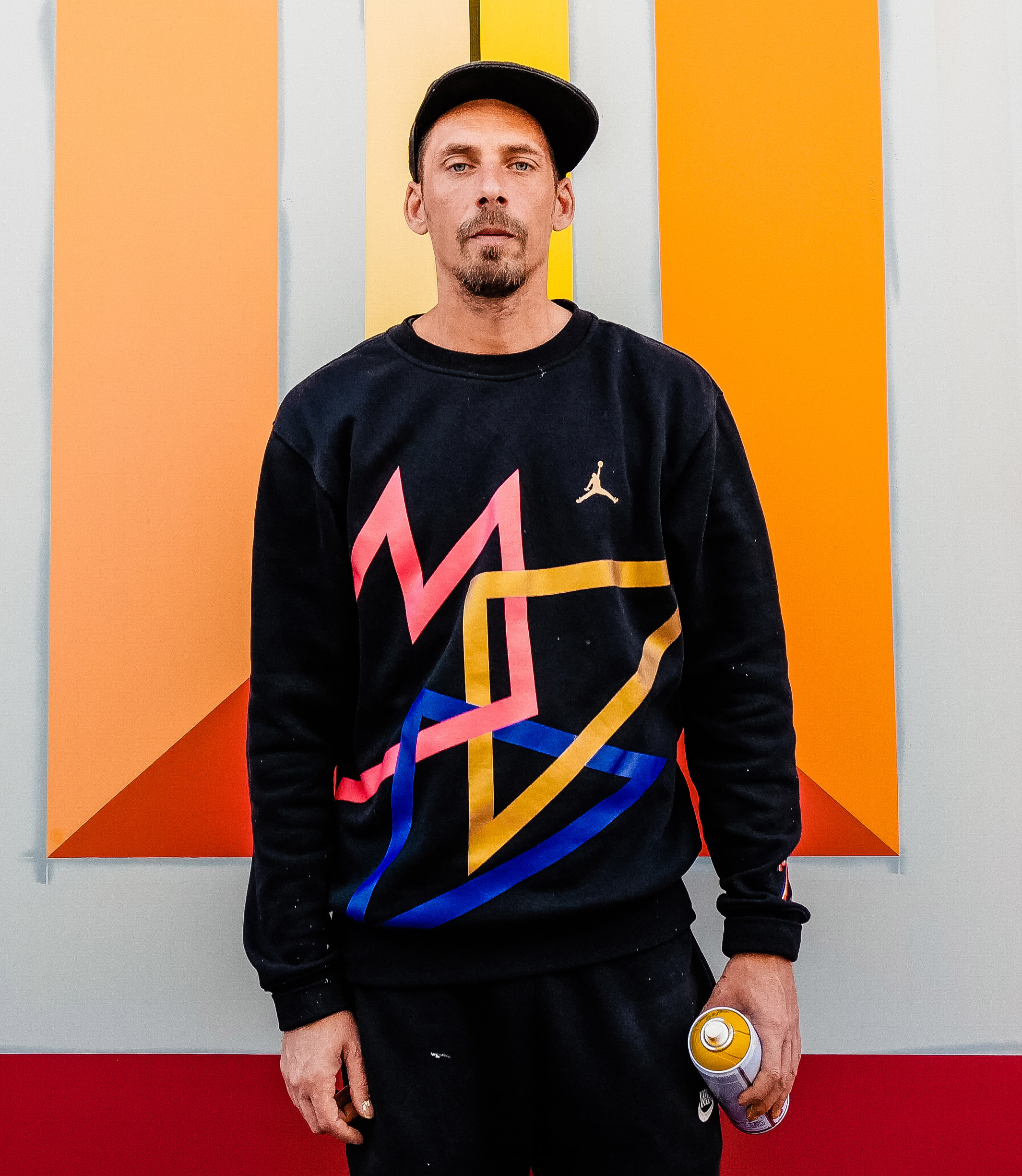Astro, a self-taught artist from the northern suburbs of Paris, began his creative journey in 2000, focusing initially on graffiti with an emphasis on lettering and Wildstyle. Over the years, he has refined his craft into a unique abstract form that seamlessly blends curves, calligraphy, and dynamic shapes. Astro’s work is distinguished by its masterful use of light, shadow, and vibrant colors, creating the illusion of depth and movement. By breaking the straightness of writing and integrating architectural perspectives, his art invites viewers into a new visual experience, challenging traditional perceptions. While Astro is widely recognized for his large-scale murals, his studio practice plays an equally important role in his artistic exploration.
In the studio, Astro continues to push the boundaries of his craft, translating his signature calligraphy and geometric style into new mediums and formats. His recent work includes a deep dive into digital art, where he explores innovative techniques to expand his abstract universe.
“I would like the viewers to feel totally immersed, to forget where they are when looking at my work, to dive entirely into my universe, my world. To lead them to discover their own abstraction and imagine things, to titillate their sense of observation and interpretation. Some will see a bird, others a face and that’s what I like. When talking with them, I see elements of my painting that I hadn’t perceived at the start.” (edited)
Astro in conversation with Clotilde Gaillard, TimeOut, 2017

Interview
Can you tell us about your artistic background? How did you get started in the world of street art?
I am a self-taught artist. My practice began in the northern suburbs of Paris in the early 2000s as a graffiti artist. Over the years, my work around letters evolved into a more abstract art. I then added perspective, graphic shapes, and optical illusions. It was from this moment on that I was invited to paint monumental facades and walls around the world, to my great pleasure.
Your work often features daring geometric shapes and optical illusions. What inspired you to develop this unique style?
I have always loved geometry, graphic shapes, and calligraphy. For a Street Art project in 2015, I completely covered the room of an apartment intended for demolition with my calligraphy. Once in the center of this piece, I realized that the calligraphies had naturally put themselves in perspective and I found the rendering very interesting. I then wanted to develop this idea of putting my calligraphies in perspective on flat surfaces, thus creating impressive optical illusions.
What role does color play in your work and how do you choose the color palettes of your pieces?
Color helps me to emphasize the perspective and depth as well as the angles and facets of my architectural constructions. The colors I use are often bright and follow the color wheel, layer by layer. However, even if most of my works are colorful, I also like to create pieces only in black and white when I want to highlight the graphic and refined aspect of a work.
Many of your works transform flat surfaces into three-dimensional experiences. How do you achieve this effect and what challenges does it present?
For me, the challenge is to "break" the flatness of the wall. When I imagine a mural, I want the viewer to be carried away by the illusion, that is, to be “tricked” by the perspective and to think that the illusion could be real. I often use simple but very effective architectures to achieve this effect because they are similar to the existing ones.
You have painted in cities all over the world. How do different locations influence your work and do you adapt your art to the environment?
I adapt my art especially to the architecture of the building I am painting on or to the surrounding architecture when there is one. I also adapt the colors to the colors of the environment, but my opinion is changing on this point because I use more colors that stand out.
How do you balance the spontaneity of street art with the meticulous planning that detailed work requires?
Indeed, there are meticulous steps in my work: the outline of the frame, the vanishing points, the shadows... However, I keep a great deal of spontaneity in my works (murals or on canvas) because all my calligraphy is done freehand, so they are all improvised at the time I paint them. Which gives me a certain freedom.
Are there any artists or artistic movements that have significantly influenced your work?
The artistic movements of graffiti and calligraphy have certainly influenced my work. Artists such as Hans Hartung, Alfonse Mucha, and Victor Vasarely or architects such as Gustave Eiffel or Zaha Hadid and architectural styles from all over the world also inspire me on a daily basis.
What motivated you to start exploring digital art and how does it compare to your traditional street art in terms of creative expression?
For me, digital art is one more medium on which to transpose my art. I like to explore new avenues, it's even what I prefer. The digital one is obvious to me because the possibilities are multiple and my art only asks to be in motion. The digitalization of it works well and offers me unlimited creativity.
How has your experience in creating large-scale murals influenced your approach to digital art, particularly in terms of composition and scale?
I usually work mainly on large formats, but also in the studio with smaller creations. It is therefore easy for me to adapt my art according to the format I am faced with.
